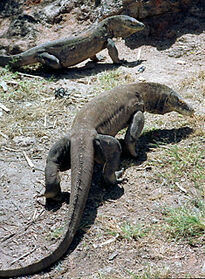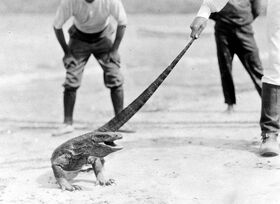The Komodo dragon is a large species of monitor lizard that can grow up to be 3.13 meters long and are found in certain Indonesian islands.
Diet[]
Komodo dragons are carnivores that feed on mostly carrion but will sometimes kill living animals. They eat by ripping large bits of meat and swallowing them without chewing.
Komodo dragons are also cannibals, and typically adults won't think twice of devouring others and younger dragons for survival.
Mating and Giving Birth[]
Komodo dragons mate in May and August, then the female finally lays the egg in September. During this time, two males will fight over mates and territory. Females lay eggs in burrows cut into the side of the hill. They usually contain an average amount of 20 eggs, and will hatch in seven to eight months. The first few years of the babies' lives are spent in trees, where they will not be eaten by predators. They are grown up in five years, and the average age that one will live to be until death is fifty years old.
In captivity[]
A Komodo dragon at Smithsonian National Zoological Park. Despite the visible earholes, Komodo dragons cannot hear very well.
Komodo dragons have long been great zoo attractions, where their size and reputation make them popular exhibits. They are, however, rare in zoos because they are susceptible to infection and parasitic disease if captured from the wild, and do not readily reproduce. In May 2009, there were 13 European, 2 African, 35 North American, 1 Singaporean, and 2 Australian institutions that keep Komodo dragons.
The first Komodo dragon was exhibited in 1934 at the Smithsonian National Zoological Park, but it lived for only two years. More attempts to exhibit Komodo dragons were made, but the lifespan of these creatures was very short, averaging five years in the National Zoological Park. Studies done by Walter Auffenberg, which were documented in his book The Behavioral Ecology of the Komodo Monitor, eventually allowed for more successful managing and reproducing of the dragons in captivity.
A variety of different behaviors have been observed from captive specimens. Most individuals are relatively tame within a short period of time, and are capable of recognizing individual humans and discriminating between more familiar keepers. Komodo dragons have also been observed to engage in play with a variety of objects, including shovels, cans, plastic rings, and shoes. This behavior does not seem to be "food-motivated" predatory behavior.
Even seemingly docile dragons may become aggressive unpredictably, especially when the animal's territory is invaded by someone unfamiliar. In June 2001, a Komodo dragon seriously injured Phil Bronstein—executive editor of the San Francisco Chronicle—when he entered its enclosure at the Los Angeles Zoo after being invited in by its keeper. Bronstein was bitten on his bare foot, as the keeper had told him to take off his white shoes, which could have potentially excited the Komodo dragon. Although he escaped, he needed to have several tendons in his foot reattached surgically.













